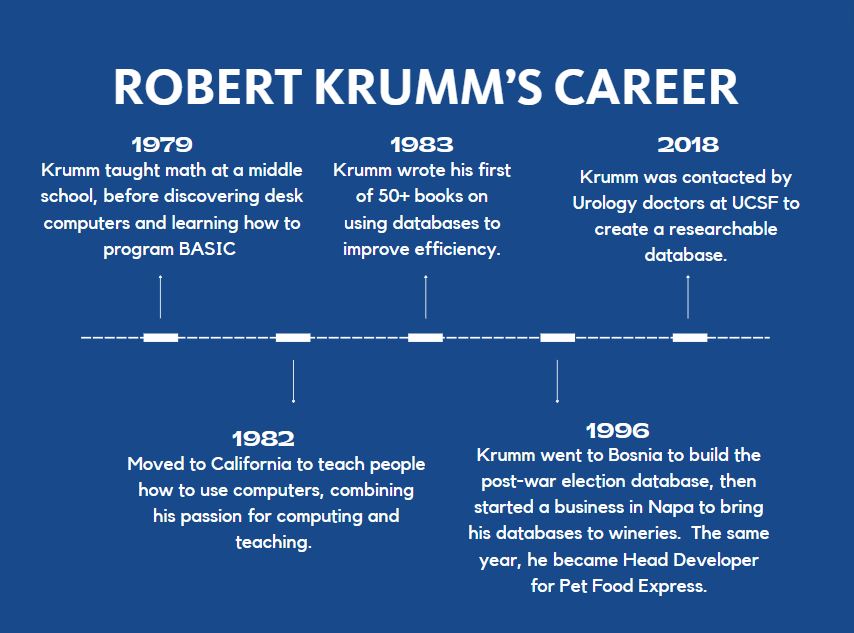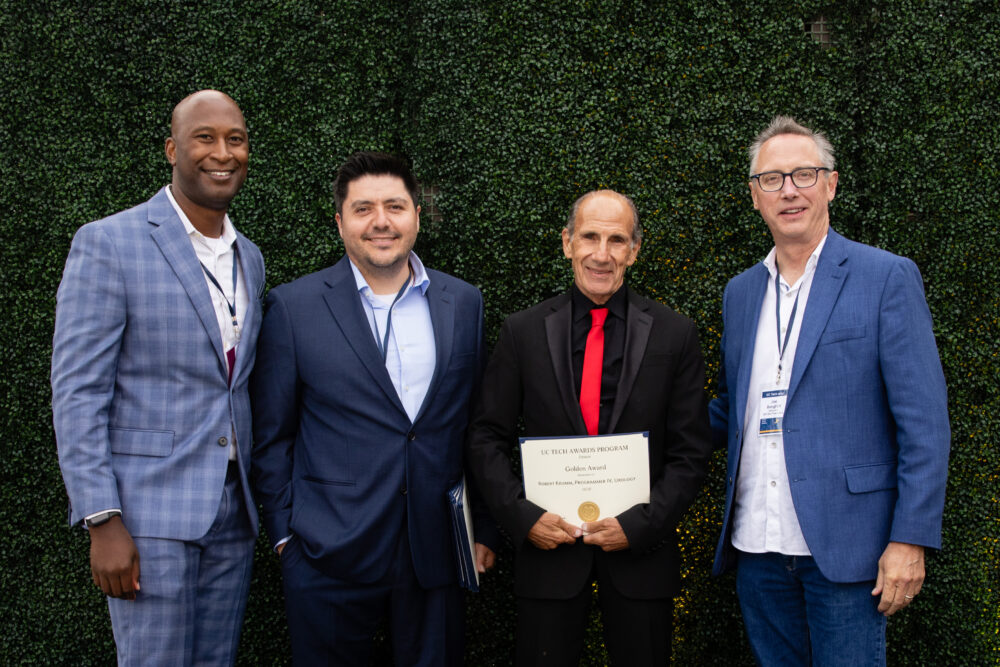By Brendon Phuong and Laurel Skurko. Robert Krumm, winner of the UC Tech Awards program golden award for design and UCSF database developer, recently shared with the UC IT Blog team his experience in developing code for hospital systems, and how his experience as a programmer in other industries (i.e. retail) informed his approach in health care. Today, with the Urology Oncology Research Database and Biobank Project Team, he works with unstructured medical records to answer important questions. The questions may sound simple, such as “How many cancer patients are treated by his department?” Getting to these answers accurately involves an expert understanding of data, and how it is collected and used. Krumm focuses on restructuring data to provide meaningful insights and answers to complex medical questions, and welcomes the opportunity to share his expertise with colleagues across domains at the University of California.
[Editor’s note: please contact UCIT Blog team know if you would like a Calendar invite to an upcoming webinar Krumm will be leading on his work on Wednesday, November 8, from 3-3:45 pm – see event notice and Zoom link, below. All are welcome.]
“Only the numbers will give you that answer.” Robert Krumm, UCSF database developer and cancer survivor, shares the conviction behind his work.
The interview transcript, below, was edited for clarity and based on a recorded interview with Krumm.
Krumm’s early career – recruited to UCSF based on data mastery developed in the online retail industry
In 1979 I was a math teacher at a middle school when I stumbled on an article about the emergence of desktop computers in Scientific American. I thought it was so interesting that I wrote a grant to acquire an Apple II to teach myself to program in BASIC while teaching. Three years later, I combined my passion for teaching with my knowledge of computers and opened my own school teaching people how to code. A year later, I continued writing over 50 books about using databases to eliminate tedious tasks and improve efficiency in all fields.
In 1996, I started my own software business in Napa, bringing database technologies to boutique wineries. Decades later in 2018, I was contacted by doctors in Urology at UCSF about pulling together various data sources into a researchable database. They looked at my code for boutique wineries and hired me, hoping to apply those systems to meet their own needs at the UCSF Department of Oncology.
Career timeline

Integrating the retail industry’s technological systems at UCSF
Prior to being hired at UCSF in 2018, I worked as a senior programmer at Pet Food Express. The retail industry was considered ahead of the data science curve at the time due to the increased need for customer experience and convenience. When I started, I hoped to bring these advancements to the hospital systems at UCSF.
I often dealt with retailers who source products from various places and want to present a diverse range to their customers, such as offering 100 varieties. Essentially, what I do for the hospital is the same thing.
How do the retail and healthcare industries relate – coding data
[Editorial note: Krumm explained how advances in retail industry technology and how data was coded and stored and used to provide insights could be applied to the health care industry. Krumm and the UCSF Urology team who recruited him were keenly aware of these synergies.]
1. Everything is Quantifiable and Necessary:
- Hospitals face a similar challenge to retail stores. They deal with numerous billing codes, which represent the same underlying medical concept or procedure
- Medical procedures are complex with different variations and types of equipment. Consolidation of information in codes is efficient and effective.
2. Surgery Data and Grouping:
- I specifically focus on surgeries and the data associated with them. Despite the potentially large number of codes associated with different surgical variations, I extract surgery-related data and utilize these isomorphic maps to group surgeries based on their shared significance. For instance, even if there are many distinct codes for different types of surgeries, I can identify the common thread that unites them, enabling a more comprehensive and meaningful grouping of procedures.
3. Reconstructing Past Data:
- Another aspect of my work involves analyzing and reconstructing treatment histories, especially for patients whose records pre-date the electronic medical record system.
- This involves pulling in data from various sources, including spreadsheets created over the years, and extracting key details like medical record numbers. By doing so, I piece together fragmented information, relying on written reports and inventories to fill in gaps and recreate a comprehensive history of treatments.
Krumm explains the three stages of data collection and analysis and their importance
[Editorial note: Krumm is passionate about his expertise in collecting, storing and connecting data with a complete understanding of how that data will be used. He encourages his colleagues to establish rigor in each of three important steps in the process.]
My role involves advocating for proper data integration and connection. When I’m in meetings, I emphasize the need for data accessibility and integration. If a system lacks these features, its potential is limited. This understanding is essential for the successful implementation of systems and technology in healthcare settings.
- Data Collection: The collection point is where the connection property is made. In a hospital exam, blood is drawn and labeled with a barcode. Without this barcode, challenges can arise since different departments have their own systems leading to a lack of connection of the data.
- Data Storage and Accessibility: The importance of integration becomes evident when dealing with new technology or systems. When considering adopting new tools or machines, the first question is often whether there’s a way to access and integrate the data. Data lakes are vital because they ensure that the data collected is not siloed but can be accessed and used by different systems seamlessly.
- Data Persistence and Connection: Data is valuable when it’s connected and integrated. Simply capturing data isn’t enough; it needs to be linked to other relevant information. Even though a doctor captures patient conversations and notes, the full value of that data emerges when it’s connected to other pieces of information. The context and connections enhance its significance.
Are there any technical skills, leadership skills, and/or diversity factors that are important to you?
The key skill is to not depend on what users say they need but to observe how they perform their jobs. This is always at variance since people take for granted details they no longer need to think about.
What do you find most meaningful about your work?
The goal of all database applications is to provide users on every level with the information they need to make choices and decisions. Often they ask for reports since they are used to visually searching lists to find the data they need. This is just as inefficient on a computer screen as it is on paper. The app should try as best as possible to find the data for the user. The goal is to get the computers to do the actual work and free the user to do what only they can do – make informed decisions.
Are there any current trends that you think will be important/people should know about or look forward to?
The primary trend is to move away from closed, vertical databases that isolate data into isolated pipelines. The future is clearly to integrate all of the data sources into a single set of linkable data domains. Research and clinical data are not separate domains but rather two sides of the same coin since what you do today is informed by analysis of what you did before. Conversely, the results of research impact the course of treatment today and tomorrow. Thus, no data source is logically separate from the others even though the current implementations lock up each POV in disconnected pipes. I have been able to get my team to look at every proposed application and ask, does it have an “integration API” so that it can integrate with all the other data.
Krumm’s love for family and running
Outside of work, I’m busy raising my grandson, who’s seven years old. I also make sure to stay active. I run about five miles five times a week, which adds up to around 1,000 miles a year. It’s a way for me to stay in shape and keep busy. We have some fun plans ahead for the summer. We’re going to visit a friend’s pet shelter for older dogs called Muttville in San Francisco.
Join webinar with Krumm on November 8th
Webinar: Robert Krumm – Coding and Database Design for Enduring Relevance [Zoom Link]
Wednesday, November 8, 3-3:45 p.m.
Host: UC Office of the President
Learning objectives: Learn how Krumm combines retail industry techniques in coding and database design to support the world’s leading urology surgeons. He will explain his methods of collecting, storing and connecting data with a complete understanding of how that data will be used.
Contact
Robert Krumm
Database developer
UCSF
Authors
Brendon Phuong
Marketing & communications Intern
UC Office of the President

Marketing & communications
UC Office of the President
[Cover image caption/Alt Text, from left to right, Van Williams, Gabriel Gonzalez, Robert Krumm (winner of the UC Tech Golden Award for Design), and Joe Bengfort]

